Mermaids: drawn to scales
Once it was ancient mariners who were irresistibly drawn to mermaids but now it’s more likely to be fashion-conscious millennials, conservation types or simply those who love being underwater
It’s Friday afternoon and postie Laura Siddall has just finished her round in Sheffield S2. This weekend she’ll leave Laura the postie behind and head to a private pool in Penistone, where she’ll slip into a custom-made tail and take on her mersona, Luna Tide-Swell, otherwise known as Miss Mermaid International 2017-18.
“I’m told I’m a bubbly and lively person anyway so Luna is just a continuation of that,” says the 33 year old. “Her back story is she was injured on the East Coast and got taken to the Scarborough Sea Sanctuary, where she met humans who nursed her back to health and cared for her. So I feel comfortable being around humans, enjoy their company and want to repay their kindness with my gratitude.”
Siddall is one of a fast-growing number of people, mostly women, taking up mermaiding – wearing and often swimming in a mermaid tail for art, performance, sport or fun.
“Mermaids represent a fantasy world, escapism, the imaginative power of the mind.”
In the past couple of years a world of fantasy has emerged where mermaids have begun popping up everywhere. The monofinned sirens have risen to the surface of beauty and fashion, TV and film, and literature and art. They’re on our cupcakes and in our lattes, and, of course, on our Instagram feeds, where #mermaidmondays are the logical way to start a week. The mer-conomy is booming.
Perhaps our fascination is a reaction to an increasingly doomy reality. Certainly they’re part of a wider cultural interest in mythology – from the ubiquitous unicorn to the rewriting of the Greek classics. The reasons for mermaids’ sudden popularity are as various as the ideas they embody.
“Mermaids represent a fantasy world, escapism, the imaginative power of the mind,” says Liverpool academic and mermaid expert Sarah Peverley. “They’ve become a quite important symbol of female power but have also been picked up by LGBT communities who are using mermaids to express difference from the standard sexual orientation that’s dominated culture. I think culturally those sorts of things contribute to their popularity now.”
For American novelist Melissa Broder, the mermaid moment may have arisen in a world that currently feels “both chaotic and instantaneously knowable”. The author of The Pisces told Big Issue North last year: “The pace at which we are bombarded by information, and in which we can find an answer to almost any question, is frenetic. But the ocean still contains mystery.
“What’s more, the top of the sea can be choppy, furious, while deep down is total silence and darkness. My interest in these elements of the sea, and the creatures that live within, reflects a desire to go inward where things are quieter, less knowable and deeper.”
But Peverley points out mermaids have always been popular – they’ve just never been so visible.
“If you go back to Victorian times they’re one of the most fantastically painted creatures. Mermaids and fairies were really popular subjects for artists to draw on. If you go back further, to the medieval church, mermaids were all over. They were carved into doorway arches, represented in the roof bosses along with other fantastical creatures like dragons, unicorns and centaurs. They’ve never actually not been popular but the speed at which images can be duplicated and shared now has contributed to the widespread, and quite relentless, dissemination of mermaid imagery across the world.”
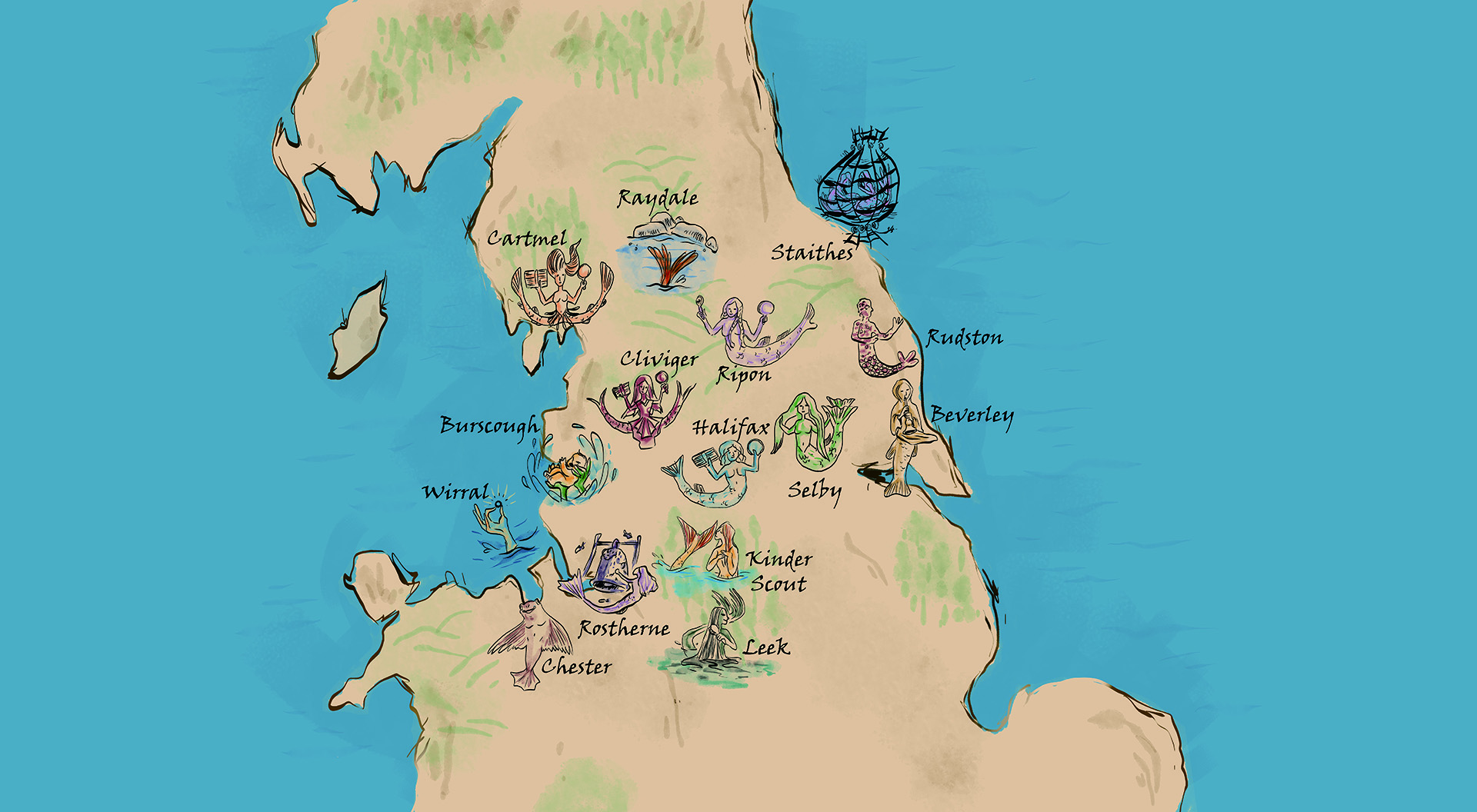
But historical depictions of mermaids were not always beautiful, as Charlotte Runcie, author of Salt On Your Tongue: Women And The Sea, points out. “In lots of stories they’re ugly and hag-like, and the scary thing about them is that they usually trick men into following them down to the depths of the ocean and eventually drowning.”
Runcie’s book, a memoir of motherhood and her connection to the sea, points out that while sea-women wreak their tricks and violence in different ways, “their most horrifying, unthinkable, chilling quality is they’re cleverer than men. Mythical sea-women almost always have an understanding of the sea that transcends the knowledge of even the hardiest, most experienced male sailors.”
Mermaids, with their strength and power over men, freedom and sexual agency, play on misogynist fears and, largely thanks to the medieval church, have long been symbols of sin and spiritual shipwreck. It’s logical that women are reclaiming their image in the same way they have reclaimed witches – both are powerful women who live outside societal norms.
“Women reclaiming the mermaid as a positive symbol is overturning centuries of patriarchal domination of the mermaid as this creature to be avoided,” agrees Peverley.
“The lessons that are taught about mermaids in a negative context are coming from men and male ideas of what women should be and how dangerous and destructive female sexuality can be for a man, so it’s nice that we’ve got the mermaid being reclaimed in these ways.”
Runcie says the image of the beautiful, alluring mermaid draws on the idea that women’s ultimate power over men is sexual, and that while Homer’s account of the Sirens has them as indistinct figures, over the centuries they have become “sanitised”, and we have come to imagine them as “beautiful temptresses who are irresistible in body as well as song”.
Of all the mermaid hashtags on Instagram the most popular, with 2.2 million posts, is #mermaidhair, usually characterised by a multicoloured ombre, often in sea greens and blues. It’s one example of how fashion and beauty have interpreted mermaid style – along with glittery make-up, shell and pearl crowns, and face jewels, all set to dominate festival fashion this year but increasingly seen in the mainstream.
At a time, seemingly, of great progress for women, make-up and beauty standards are more elaborate and consuming of both time and money than ever before. The mermaid, although a symbol of female empowerment, takes the beauty myth even further.
In her book Perfect Me, Heather Widdows, professor of global ethics at Birmingham University, argues that beauty has become a moral ideal in today’s visually and virtually dominated world – a sign of our worth.
“The mythical beauty trend fits very well with the claims that I make about the imagined self, which is increasingly a virtual self, the selfie self, and is increasing less human,” says Widdows. “It’s one with perfectly smooth skin, firm, pert bodies, big eyes – those are the things that we’re moving towards, which are mythical, and mermaids are the end point of that.”
The philosopher adds that the mermaid look is part of a general move towards the normalising of very modified bodies.
“There’s a ratcheting up of what’s required just to be normal. If we think about the top end of that as the mermaid look, the doctored selfies, the bottom end is what we just have to do to be presentable, and that’s things like body hair and straight teeth…
“The rise in body image anxiety is at epidemic proportions and it doesn’t matter who you are, we need to address it.”
Anita Jasso, a performance mermaid and professional free-diver from Harrogate, bristles at the beauty practices associated with mermaiding.
“I hate it. I find it so archaic, the pageants especially. That has been campaigned about since the 1950s – a lot of the girls do it,” says the 38 year old.
“The problem is a lot of it is quite Disneyfied. I was eight when The Little Mermaid came out and I don’t get it. The whole film is about a mermaid not wanting to be a mermaid and trying to get legs, and sacrificing something that was obviously really important to her to go and run away with a bloke. From an empowerment perspective, and from a mermaiding perspective, how can that inspire you to want to be a mermaid?”
The popularity of the 1989 Disney film – set to receive a live-action reboot – is cited by many, including Peverley and Imogen Hermes Gowar, author of The Mermaid and Mrs Hancock, as the reason for now grown women living out their childhood fantasies in the water.
“I’m of the generation that grew up with The Little Mermaid,” says Hermes Gowar. “That was really present in my consciousness, so I think the current popularity of mermaids was seeded 30 years ago in the ambitions of small children.
“But I think it’s a lot more complex than that. The way people are interested in mermaids nowdays, I think there is a kind of sexuality to it. These traditional mermaids that can be a bit dangerous and equivocating – maybe that’s the attraction to it.”
In 2016 young adult author Louise O’Neill was charged with providing a more progressive version of The Little Mermaid. Her book The Surface Breaks is a feminist reimagining of the tale.
“I had been a huge fan of the fairytale and the movie as a child, but it was only as an adult that I could see both were problematic,” she says. “This was the story of a young woman mutilating her body in the hopes that a man she barely knows will fall in love with her, sacrificing her family, her home and, most importantly, her voice, along the way. What sort of message was that for young women? I wanted to give the Little Mermaid agency and restore her voice.”
Andersen’s 1837 tale is unusual in that it portrays a mer-world under patriarchal rule, when mermaids are usually portrayed as autonomous females, an area O’Neill was keen to explore in her story.
“The obsession with the female body, the demands that women attain what are often unattainable standards of beauty, the pressure that is put on women to conform to gendered stereotypes – these all have a massive impact on our emotional wellbeing, as it does for the Little Mermaid.”
The writer agrees that the “easiest explanation” for the recent fascination with mermaids is that it is being driven by millennials who grew up on the Disney film but says it’s interesting that it is happening simultaneously with the #MeToo movement, when women have refused to be silenced any longer.
“We have been telling our stories, loudly, and demanding that we be heard. Mermaids are also emblematic of a certain duality that women – cast as either the Madonna or the whore – have rarely been afforded. Mermaids can be both vengeful and vulnerable, and are allowed to express both sides of their nature, something more of us human women are determined to do.”
The link between mermaids and prostitution dates back as far as the sixth century, according to Peverley, and has been intermittently brought out to use against women. But it has also been a means of exploring the idea of female sexuality in a safe way, because she’s a mythical creature.
“Saint Isidore of Seville associates the sirens with prostitutes and says they were in fact real women who lured men to their financial and spiritual ruin with their bodies. So it’s a very early idea, that sex and the siren are connected together, and then this gets taken up in the medieval church when the mermaid is frequently associated with sexuality – avoid looking at women or getting involved with women because they’ll lead you to ruin.
“It’s just continued from there and had revivals at specific points in time. There are times it becomes more prominent as an idea and then it’s sunk into the background.”
It’s a link made by Hermes Gowar in her book when Mrs Chappell, the madam of an upscale brothel in Georgian London, procures the “real” mermaid of the book – a grotesque, mummified foetus torso attached to a fish tail – as a means to lure men to her premises, where her girls are instead dressed as though they had just emerged from the sea, adorned in pearls, their pubic hair dyed seaweed green.
“I think in my head it was partly to do with this fantasy thing that we want mermaids to be a particular way and it’s a kind of performative sexuality from women which is really not that different from any kind of wish fulfilment that sex workers offer – especially in that period with these lavish brothels that were just such a display of sexuality and this idea that you can have whatever you want,” she says. “That tied in with the idea of this grotesque mermaid and the way we imagine a mermaid to be.”
Mermaids, she continues, provide a stand in for the scarlet woman.
“You’ve got your sailor going to sea. The idea of him being lured into the arms of this sexy powerful mermaid, who just goes about by herself and is not controlled by men – that’s more comfortable than thinking of him having a woman in every port and they’re ordinary women and he could help it.”
She points out that independent women with sexual agency have historically ended up being tied to prostitution.
“In the 18th century women only had to take place in public life – keeping a shop and not being married to a man who owns the shop, for example. You’re already taking part in a public transaction, you have control over something and you’re not deferring to a man, therefore there’s something really suspect about you and it always gets boiled down to sexual misdemeanours – being accused of prostitution or witchcraft.”
Peverley’s answer to the question of whether mermaid imagery is a symbol of female empowerment or objectification is that it’s both. Duality is present in the mermaid community too, which Jasso says is striving to define itself.
“It raises quite uncomfortable questions as well as quite interesting ones about liberation,” says Peverley. “But I don’t think there’s any escaping that dualism because we’ve inherited so much in terms of power dynamics and social constructs.
“Mermaids are so inextricably bound up with the history of those that it’s very hard to detach her, in any sense, and say, right, we can see her now as wholly positive or wholly negative. Maybe that’s part of the ongoing fascination.”
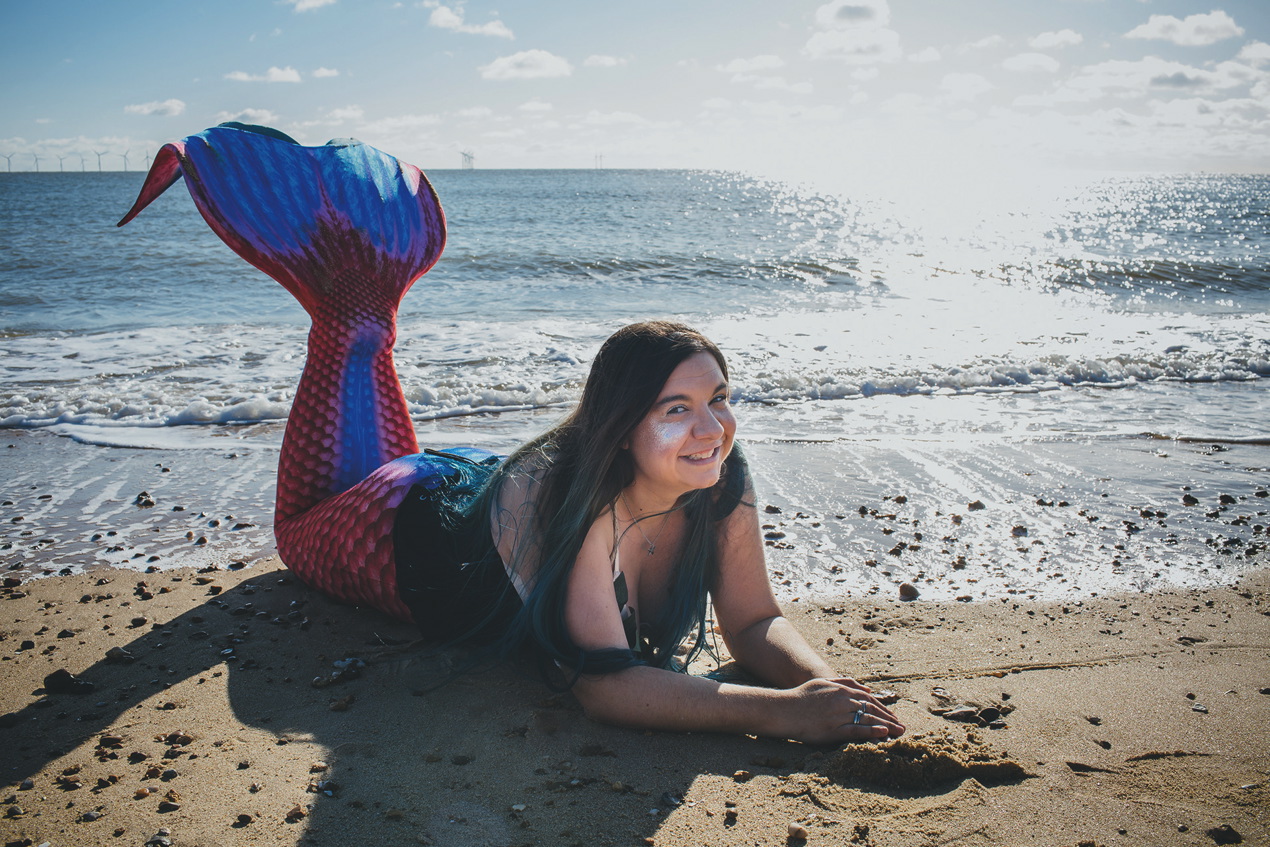
Otherwise known as Carla Watkins, mermaiding entrepreneur, aged 32 (mermaiding.co.uk)
I’m a photographer and I took up mermaiding in 2015 just because it looked really joyful and lovely. Then a few friends said: “Oh, I’d love to try your tail on. I’d love to have a photoshoot.” A lot of people just wanted a pretty picture for Instagram so I let them try my tail on and took photos in my studio, and that spiralled into offering a mermaid experience for adults.
I now do hen parties where we do things like making shell bras and mermaid crowns. I do the occasional performance, although generally not in water. We did a charity event last year where we sat on an arrangement of rocks giving necklaces to guests.
The swimming part for me is still very much just a joy. It all came about when I found a video of Hannah Mermaid, who’s really pioneering. I saw her swimming in a mermaid tail with whale sharks and I just thought, my god, I have to try this. It was like seeing fantasy brought to life.
It took me a few years to track down a suitable tail and then to find a pool that would let me swim in it, but when I did I was completely hooked. If you’re starting out you could spend anything from £100-200 on a lycra tail. Next up is neoprene for performing – realistic looking, bigger and heavier. Mine came to about £600. The next step up is silicone – you can spend up to six grand.
I swim off the coast as much as I can but I’m not as hardcore as other mermaids who swim year round. I love it but not enough to freeze. I train at a local pool.
The primary appeal for me is freedom. I describe the swimming as flying underwater. You focus on what you’re doing and you’re aware of yourself and your body but everything else floats away and that for me is a really magical, important sensation. It’s a form of escapism, I guess.
I get a kick out of performing but it’s never been about sexiness or for the male gaze. In the community I would say that’s not generally a thing.
Women are unfortunately very critical of ourselves so one of the reasons I wanted to do mermaiding more publicly is to be visible. I’m not skinny and I’m unlikely to ever be Ariel size or shape – if I can do it, you can do it…
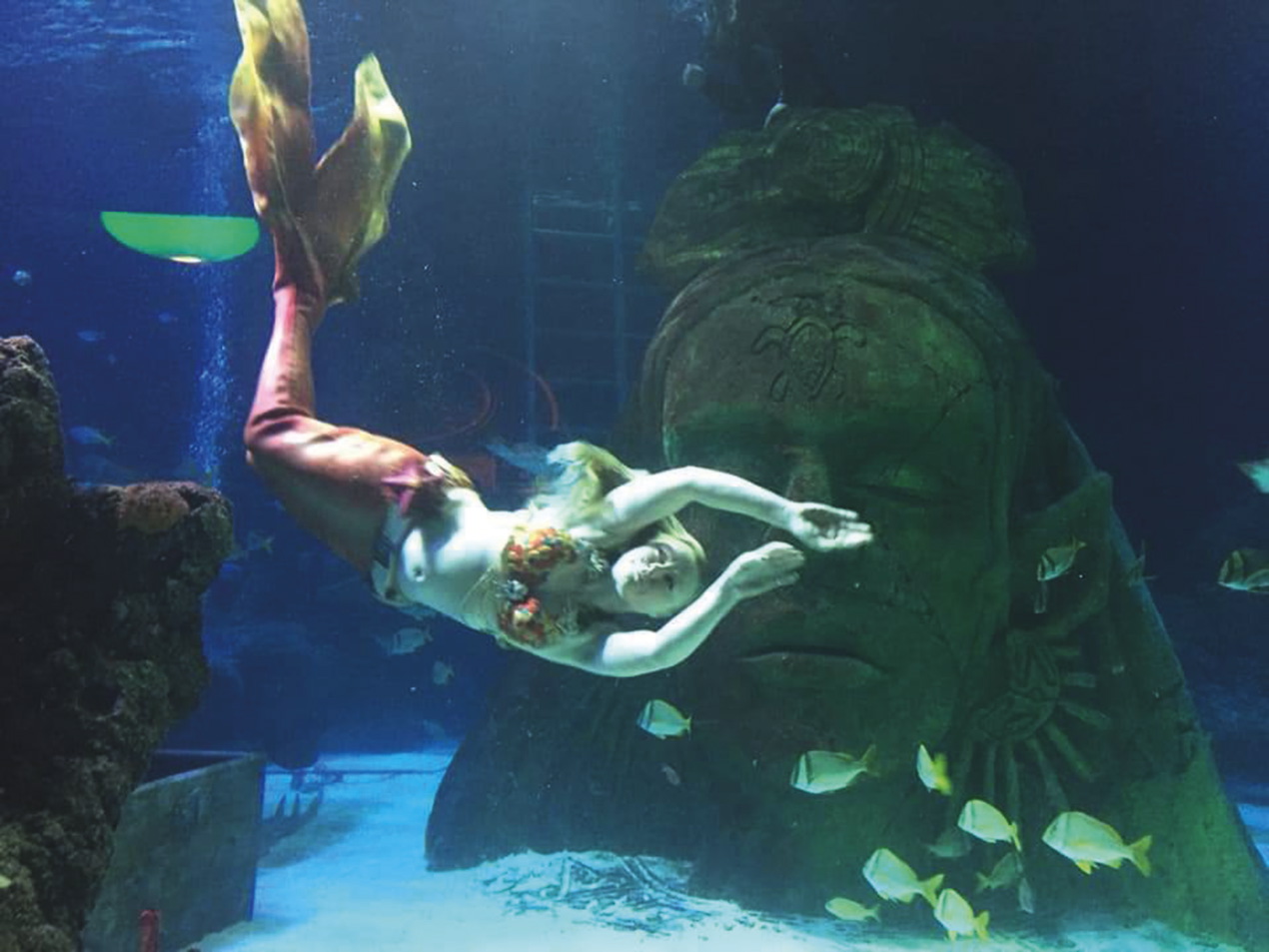
When I first started it was a hobby. I was a costume maker and it was a real struggle trying to make ends meet. I thought I should try something new, just for myself, so I decided to make a latex mermaid tail. I took my first swim in August 2016 at a festival with a swimming pool. I just asked politely and they said go for it.
I headed to the Merfolk UK convention and from there I was asked to join Hire a Mermaid UK to do kids parties. Now I free-dive as well so I’ve ventured down a lot of avenues, which I didn’t think I would. The ultimate dream was to swim in aquariums and I’ve done it. The most regular are
Blue Planet at Cheshire Oaks and we’ve got a residency at Manchester Sea Life, so these little bits of income are creeping in but I wouldn’t feel comfortable risking my mortgage.
I love being able to produce something that makes people smile – and not just kids. We’re always amazed at the response we get from the adults as well. It’s just really nice to bring that imagination to life.
I feel that it is very feminine. But there are men out there who enjoy it for the same reasons we do. It’s a freedom thing. You can just put your head under water and forget, just enjoy your own space.
I entered Miss Mermaid Yorkshire for a laugh. But I got picked, and headed to London for the UK final. In the first round you had to make an eco costume, so that was about recycling, marine conservation and plastic awareness – they use that platform to promote it. I was in my element with that one but the rest of it was very pageanty. I’m no beauty girl – I’m a postie for a living and a bit of a tomboy, but the group of girls that were there were all so supportive of each other.
Then I got selected for Miss Mermaid England – oh my goodness. I got my little tiara and my bunch of flowers. Then I got picked to represent the UK and went to Egypt. There were 22 countries represented and what I loved about it was we all got on. It was awesome. And I won the world title.
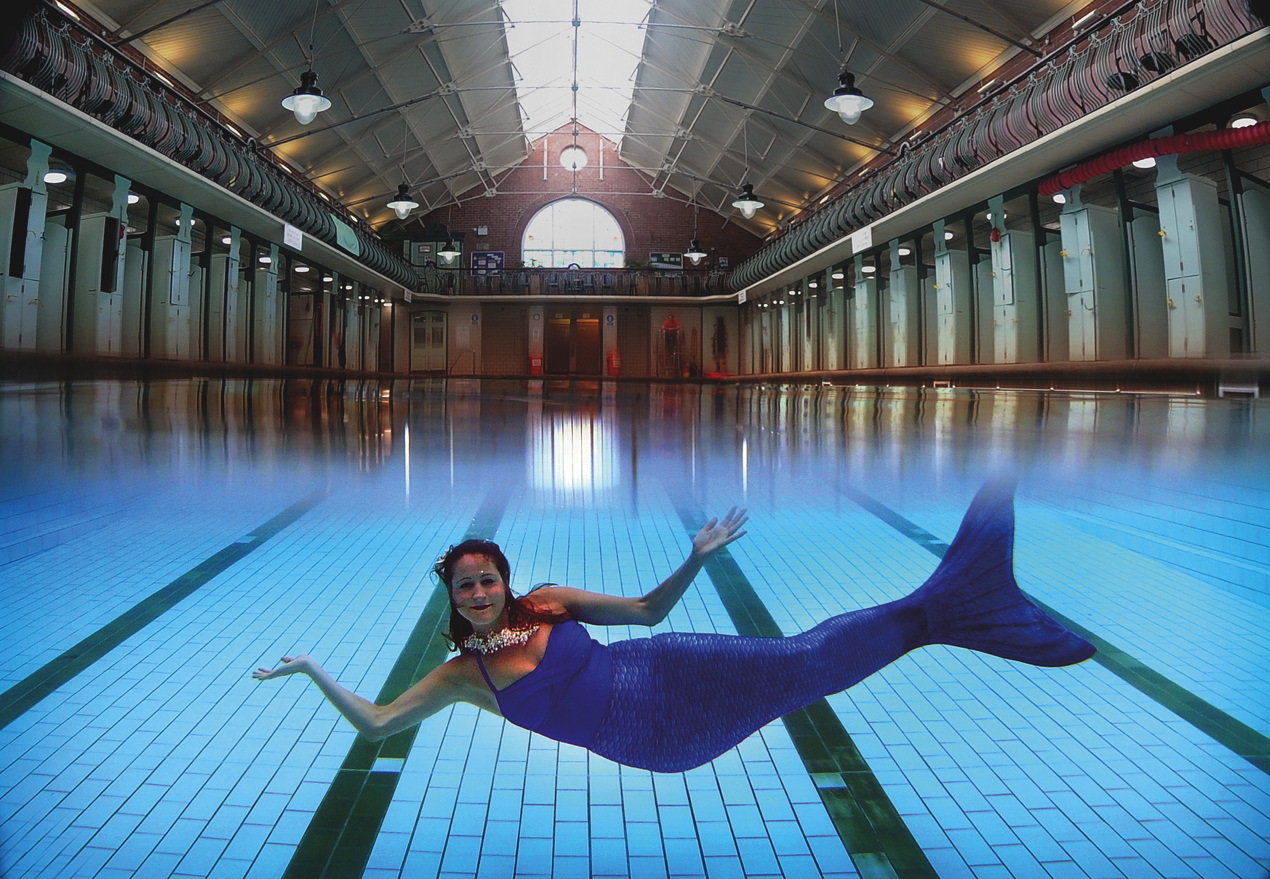
I started as a synchronised swimmer and competed in county championships but when I came to university I retired because if you want to get higher than that you have to concentrate. Then about 10 years ago I was asked to be in an interactive show at a swimming pool and I realised how much I missed it so I started trying to find places I could do it for fun instead of competing but there was nowhere.
After I wrote a blog saying maybe I’d do it on dry land a choreographer got in touch, Zoe Parker. We went to the pool and I started teaching her synchronised swimming. It started off as a dry land show – I love Esther Williams and those old films and formation routines – and we turned that into a six person show that we took around the festival circuit.
Little girls were obviously really into it so we started running mermaid classes. We run a very basic synchronised swimming water-based class that we occasionally have tails in. That’s for adults. Then we run mermaid courses for kids where they do synchronised swimming, and we do tail Thursdays where they get to swim around as mermaids.
There is a fascination with it. Every time we have someone who puts the tail on they say: “Oh, this is the best day of my life.” It’s really lovely. We’ve had a few men in the tails too. I do think it’s a freeing experience because you can swim really fast in them.
There’s a big community of mermaids, and every one I know has a deep connection with the ocean and conservation – particularly with sea creatures in captivity. They do campaigns like mermaid beach cleans. As ocean dwellers it’s about cleaning up your own environment.
In February we held the Human Aquarium exhibition with photography, films and installations made out of single-use plastic made by artists and our plastic-free youth group. We worked with a group of very hardy and lovely sea swimmers and shot them as merfolk washed up on Redcar beach. We used women and men. We don’t want to be sexist about it.
Radiographer-cum-mermaid, choreographer and competitive freediver, aged 38, from Harrogate
I went on a scuba holiday in 2014 in the Red Sea. Kat Grey, one of the instructors, was also a free-diving instructor, underwater model and a professional mermaid and she offered us the opportunity to have a go at free-diving and mermaiding, so we anchored in a lagoon and tried our hands. Soon I was skipping scuba diving to go off to do that.
Free-diving took over from scuba diving in my hobbies. Scuba divers go and practice and they’re lumbering along with all their equipment and you’re just sauntering around with a monofin. It’s the feeling in the water that you get – a definite sense of freedom, and the fact that you can interact with wildlife a lot better. You’re not blowing bubbles so you’re not scaring them off. I can hold my breath for five minutes when I’m in training.
Mermaiding isn’t a challenge in the same sense. When free-diving you have to look inwardly and allow yourself to go down to depths – mermaiding is a shorter breath hold. The challenges are cold-water tolerance, being able to see and allowing water to go up your nose and not actually being bothered about it.
A mermaid friend of mine, who is also a competitive freediver, Maša Šorn, and I do mermaid choreography and perform in aquariums. We can both swim 150m on one breath but the mermaiding is a bit of a respite from competition training. It’s still training but it’s really fun and there’s a social side to it.
I don’t really go for the aesthetic side of mermaiding and I am a bit of a black sheep of the community as I don’t do any children’s parties. A lot of people got into it through children’s entertainment whereas for me mermaiding came first and I don’t need to use it to make money. I have a job.
I don’t really like that side of things and I don’t like the social media side or the commercial side. Kids love mermaids and are a captive audience, so if you’re doing a children’s party or you’re in an aquarium I think you should be promoting things like plastic awareness. What I see is face painting and helium balloons and glitter make-up when this is a perfect opportunity to say, actually, glitter is a micro-plastic, let’s not use glitter. If you teach kids they can actually teach the adults.
There’s a lot of clambering for what this community is about. It’s trying to define itself and find its identity and I would love it if it went in the direction of awareness around conservation rather than the narcissistic social media side.
Main image: Laura Turner
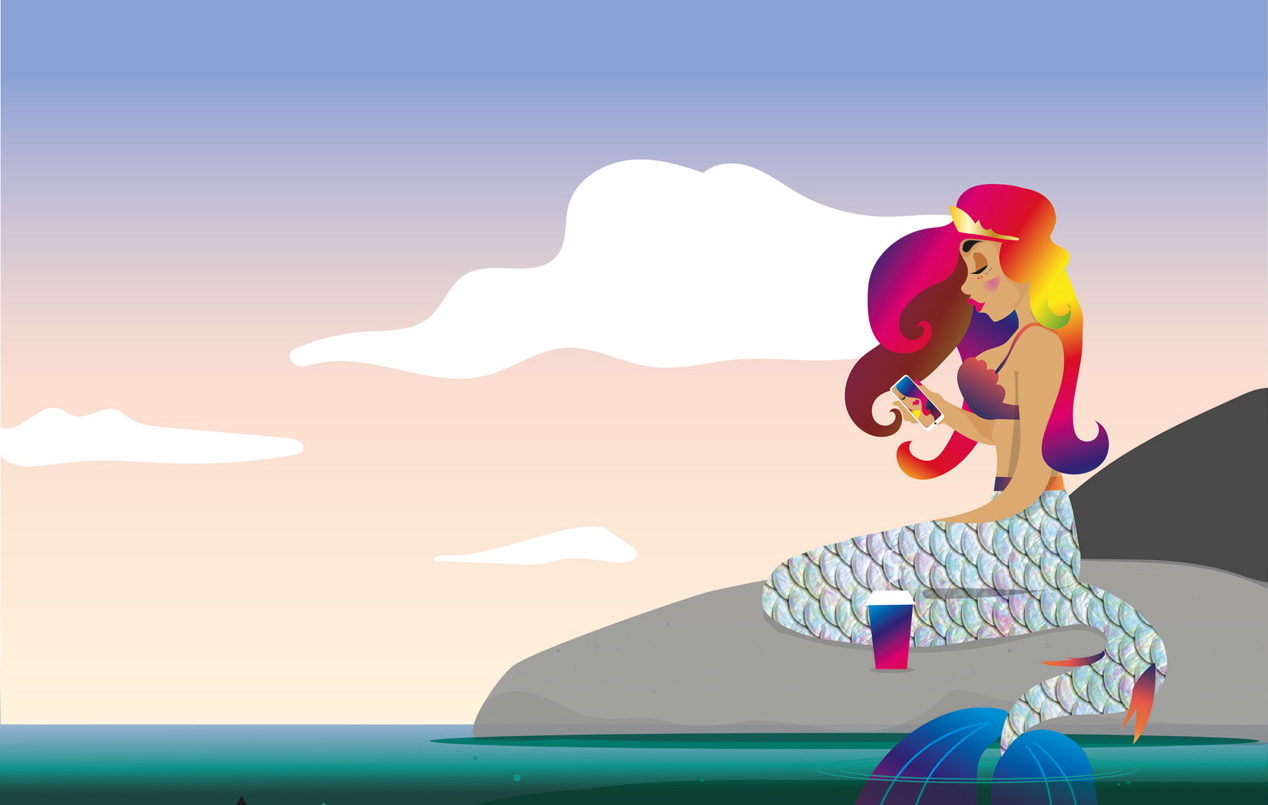
Leave a reply
Your email address will not be published.